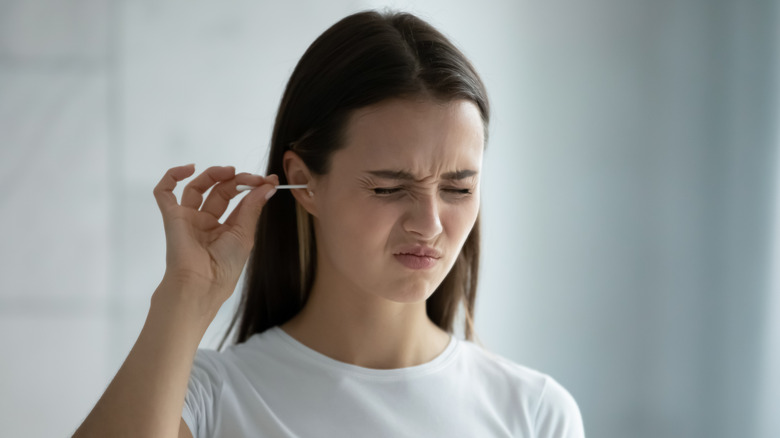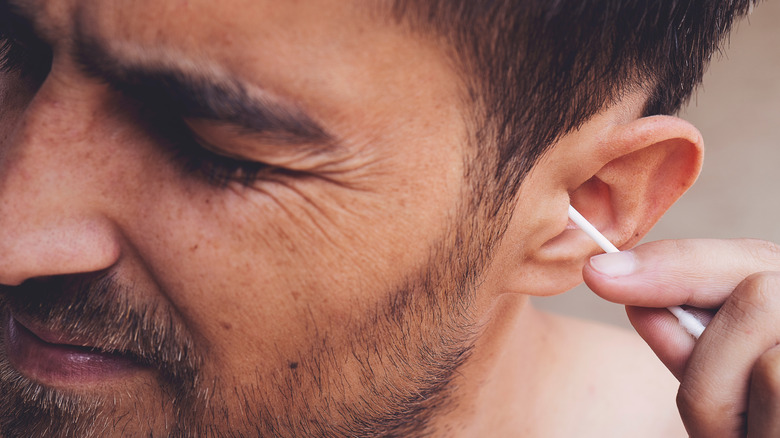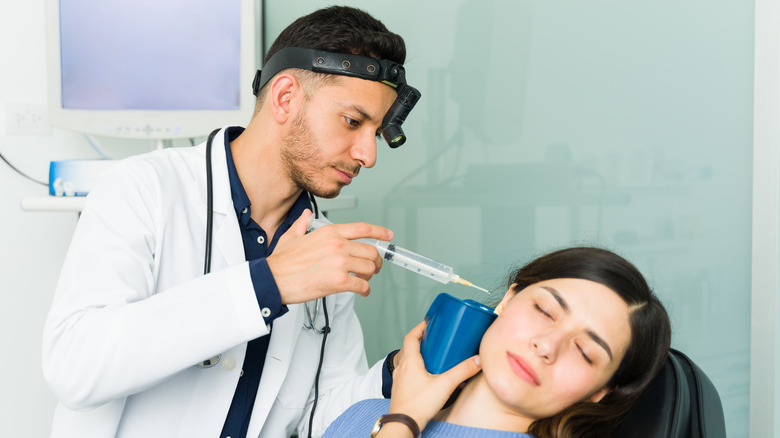Here's Why You Should Never Use Q-Tips To Clean Your Ears
From touching up nail polish to fixing mascara smudges, there are many things that cotton swabs, or Q-tips, are known to be used for. However, arguably one of the most popular uses for them is to clean out earwax (via Insider). Excessive wax can cause itchiness and liberating your ear from that sticky blockage can be a relief. Not to mention, some people experience oddly satisfying scratching sensations from Q-tips.
With all these benefits, there's nothing not to love about Q-tips, right? Wrong. According to experts, you can use cotton swabs for many cosmetic and hygienic purposes, except for removing earwax. Before you call this blasphemy, Insider recommends checking your Q-tip box, where you'll find a warning label that reads: "Do not insert swab into your ear canal." The reason behind this is that plunging Q-tips into your ear canal doesn't pull the earwax out. Instead, mindlessly swabbing pushes the substance deeper inside and makes it that much harder to be removed, ear specialist Dr. Yu-Tung Wong explained to Cedars-Sinai.
If you've been using Q-tips wrong your whole life and are wondering how you will stop, here is some information that will help you think twice the next time you're about to stick one into your ear.
Q-tips can damage your ears
According to Cleveland Clinic, earwax is made up of dead skin cells, hair follicles, and discharge from two glands within the ear. It has antibacterial properties and lubricates the ear, as well. In other words, earwax is created by the ear in order to clean the ear. But too much of it can make your ear canal feel greasy and itchy. And while most times the act of chewing pushes the wax through the canal and it simply falls out, there are other times when manual ear cleaning is needed.
In that situation, steer clear of cotton swabs, and don't even think about using bobby pins, your fingers, or even candles. The inevitable outcome is that you'll push the earwax further into your ear. "Over time, this causes cerumen to build up and eventually it can dry up and totally block the ear canal," Dr. Lindsay Bondurant, director of the Pennsylvania Ear Institute, explained to Salus University. In worst-case scenarios, you can even rupture the sensitive structures in your ears and cause hearing loss.
You might reason that you're usually very careful and slow when inserting a swab into your ear, but accidents do happen. It's better to err on the side of caution and learn to give Q-tips a pass.
Safer methods for ear cleaning
You might think that Q-tips corner the market when it comes to removing earwax, but there are alternative methods that can give you the same result at a lower risk. Microsuction is commonly performed by ear, nose, and throat (ENT) specialists to remove earwax (via Healthline). During the procedure, earwax is dislodged and pulled out using a long, thin vacuum device. When performed properly, microsuction is quick and painless.
If you prefer at-home earwax treatments, you can use over-the-counter ear drops that contain hydrogen peroxide or oil to soften the wax. HealthPartners recommend the necessary steps for this method to work: First, lie on your side with your impacted ear facing up and apply the recommended amount of drops into your ear canal. Continue lying in that position for a couple of minutes to let the drops reach the eardrum, then sit up to let any remaining drops drain out into a tissue. Using a blow dryer set to low heat aimed at your ears can safely dry up any remaining liquid.
An annual visit to a specialist to check on the health of your ears may be necessary depending on how much wax your ears naturally produce. But no matter what problems you have with earwax, just remember to keep your hands off the Q-tips.


